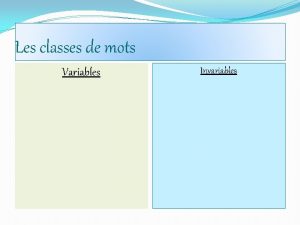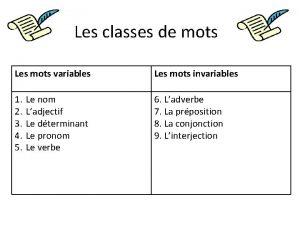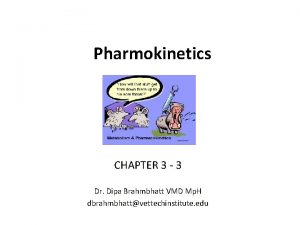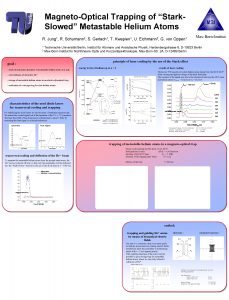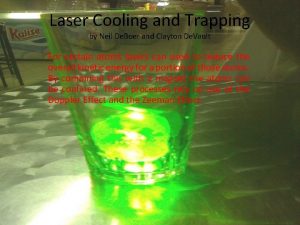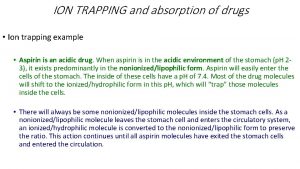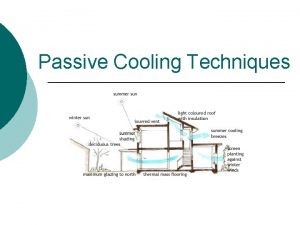Laser Cooling and Trapping MagnetoOptical Traps MOTs Far









- Slides: 9

Laser Cooling and Trapping Magneto-Optical Traps (MOTs) Far Off Resonant Traps (FORTs) Nicholas Proite

Optical Molasses n When a cloud of atoms enter an on-resonant laser beam, they inelastically collide with the photons. The field exerts a force on the atoms which ‘pushes’ the atoms. n The key idea: detune the laser to below the atomic resonance (d≈5 MHz). Due to the Doppler effect, only atoms moving towards the light source will see the light as resonant. These atoms will slow until they are no longer resonant with the light. Atoms moving towards the light source will resonate with the light field.

Optical Molasses Dynamics I n The force exerted by the light field is therefore a dampening, velocity-dependent force. 85 Rb Parameters: Laser = 780 nm Intensity = 2*ISAT g = 2 p 6 MHz d=g/2

Doppler Temperature n Each atom that absorbs a photon will later emit that photon into a random direction, limiting the minimum cooling temperature (the Doppler Temperature). The Doppler Temperature is commonly overcome with more advanced cooling techniques. Find TDoppler by equating the competing processes: cooling = heating Amazingly, find that: MHz

Magneto-Optical Trap While dampening the velocity using Optical Molasses, we can turn on magnetic fields (anti-Helmholtz coils) which have a zero in the center of a vacuum chamber. Where the energy levels will be Zeeman shifted off-center, the OM lasers will have the greatest impact in the exact center. b: laser intensity and detuning parameter k: magnetic field and Zeeman parameter http: //maildbs. c. u-tokyo. ac. jp/~torii/bec/tutorial/Image 3. gif

Magneto-Optical Trap (MOT) n The atoms start at a few Kelvin and cool down until they enter the linear-force regime. Overdamped Linear-Force regime When the atoms are slow enough, they experience overdamping

Dipole Force Optical Trap n n When a powerful laser beam is directed at an atomic sample, the energy levels will Stark Shift. If the beam is red-detuned, the Stark Shift will lower the energy of the atoms. This position-dependent shift is greatest at the focus of the laser beam, creating a Gaussianshaped potential. To keep the atoms from cycling in the resonant transition (and therefore scattering photons and heating), we the laser is detuned on the order of THz. . d= 16 THz Intensity = 100 W / cm 2 gscatter ≈ 1 at focus gspon = 2 p 6 MHz d. Stark = 125 MHz at focus waist = 10 mm parameters from Heinzen, PRA 1993

MOT-FORT Interaction n n We can use the both of these traps simultaneously but first need to consider that the electric field from the strong FORT beam will Stark Shift the atom’s levels in a position-dependent manner. These plots are based on: initial velocity = 1 m/s initial position = -10 microns FORT Only MOT & FORT

Final Remarks n n n The recoil noise from the MOT beams is small compared to the FORT potential well, and within these parameters is not problematic (figure). With the MOT off and FORT on, the oscillation frequency in the simulated oscillation frequency was about 20% different from the calculated oscillation frequency. Lastly, fast velocities were problematic in the FORT simulation due to resolution issues that will need to be overcome.
